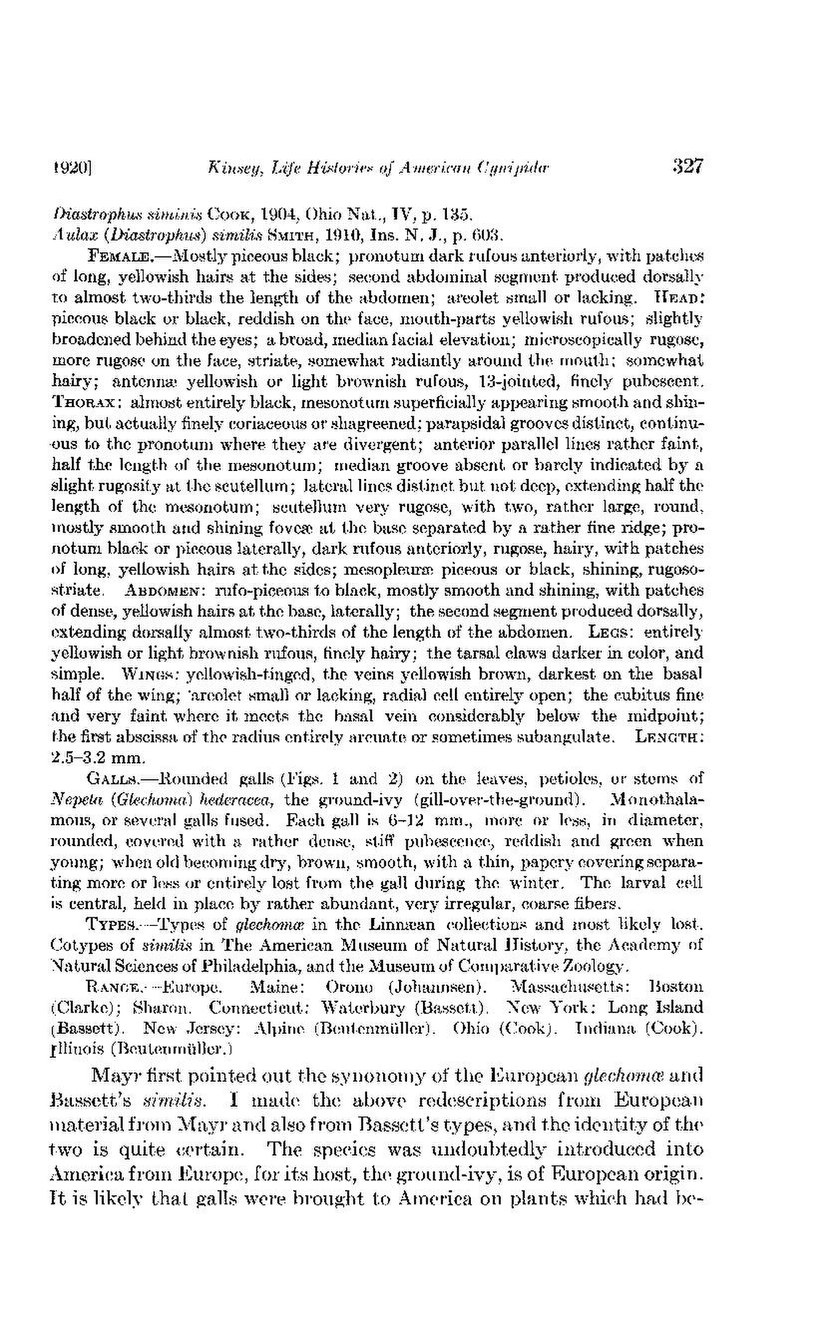Diastrophus sitninis Cook, 1904, Ohio Nat., IV, p. 135.
Aulax (Diastrophus) sitnilis Smith, 1910, Ins. N. J., p. 603.
Female.—Mostly piceous black; pronotum dark rufous anteriorly, with patches of long, yellowish hairs at the sides; second abdominal segment produced dorsally to almost two-thirds the length of the abdomen; areolet small or lacking. HEAD: piceous black or black, reddish on the face, mouth-parts yellowish rufous; slightly broadened behind the eyes; a broad, median facial elevation; microscopically rugose, more rugose on the face, striate, somewhat radiantly around the mouth; somewhat hairy; antennæ yellowish or light brownish rufous, 13-jointed, finely pubescent. Thorax: almost entirely black, mesonotum superficially appearing smooth and shining, but actually finely coriaceouis or shagreened; parapsidal grooves distinct, continuous to the pronotuim where they are divergent; anterior parallel lines rather faint, half the length of the mesonotum; median groove absent or barely indicated by a slight rugosity at the scutellum; lateral lines distinct but not deep, extending half the length of the mesonotum; scutellum very rugose, with two, rather large, round, mostly smooth and shining fovec at the base separated by a rather fine ridge; pronotum black or piceous laterally, dark rufous anteriorly, rugose, hairy, with patches of long, yellowish hairs at the sides; mesopleuræ piceous or black, shining, rugoso-striate. Abdomen: rufo-piceous to black, mostly smooth and shining, with patches of dense, yellowish hairs at the base, laterally; the second segment produced dorsally, extending dorsally almost two-thirds of the length of the abdomen. Legs: entirely yellowish or light brownish rufous, finely hairy; the tarsal claws darker in color, and simple. Wings: yellowish-tinged, the veins yellowish brown, darkest on the basal half of the wing; areolet small or lacking, radial cell entirely open; the cubitus fine and very faint where it meets the basal vein considerably below the midpoint; the first abscissa of the radius entirely arecuate or sometimes subangulate. Length: 2.5–3.2 mm.
Galls.—Rouniided galls (Figs. 1 anid 2) on the leaves, letioles, or stems of Nepeta (Glechoma) hederacea, the ground-ivy (gill-over-the-ground). Monothalamous, or several galls fused. Each gall is 6–12 mm., more or less, in diameter, rounded, covered with a rather dense, stiff pubescence, reddish and green when young; when old becoming dry, brown, smooth, with a thin, papery covering separating more or less or entirely lost from the gall during the winter. The larval cell is central, held in place by rather abundant, very irregular, coarse fibers.
Types.—Types of glechomæ in the Linnæan collections and most likely lost. Cotypes of similis in The American Museum of Natural History, the Academy of Natural Sciences of Philadelphia, and the Museum of Comparative Zoology.
Range.—Europe. Maine: Orono (Johannsen). Massachusetts: Boston (Clarke); Sharoin. Connecticut: Waterbury (Bassett). New York: Long Island (Bassett). New Jersey: Alpine (Beutenmüller). Ohio (Cook). Indiallna (Cook). Illinois (Beutenmüller.)Mayr first pointed out the synononmy of the European glechomæ and Bassett's similis. I made the above redescriptions from European material from Mayr and also from Bassett's types, and the identity of the two is quite certain. The species was undoubtedly introduced into America from Europe, for its host, the ground-ivy, is of European origin. It is likely that galls were brouight to America on1 plants which had be-
